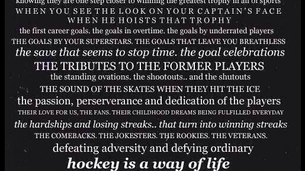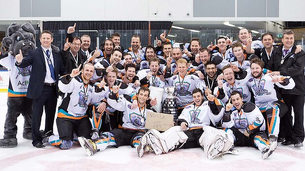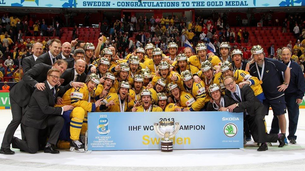ICE HOCKEY
"Modern ice Hockey is a competitive game that is played on an ice rink by two teams made up of an equal number of players wearing skates, who play using a codified set of rules, and use sticks to try to propel a puck though their opponents' goal"
Before the codification of sport in the nineteenth century, stick and ball games existed as early forms of field and ice surface entertainment and ceremonial practices in indigenous cultures across the world. There may have been cross fertilisation, or in the case of the native South American palin - the chueca game or Isle of Man camogie game, eradication, of playing styles through the ages as civilisations and empires rose and fell, but the human impulse to propel a ball or puck through use of stick or body is a universal emotion that lay at the root of society’s greatest sports today.
Ice Hockey is played on a large flat area of ice, using a three-inch-diameter (76.2 mm) vulcanized rubber disc called a puck. This puck is often frozen before high-level games to decrease the amount of bouncing and friction on the ice. The game is contested between two teams of skaters. The game is played all over North America, Europe and in many other countries around the world to varying extent. It is the most popular sport in Canada, Finland, Latvia, the Czech Republic, and Slovakia.
The governing body of international play is the 66-member International Ice Hockey Federation (IIHF). Men's ice Hockey has been played at the Winter Olympics since 1924, and was in the 1920 Summer Olympics. Women's ice Hockey was added to the Winter Olympics in 1998. North America's National Hockey League (NHL) is the strongest professional ice Hockey league, drawing top ice Hockey players from around the globe. The NHL rules are slightly different from those used in Olympic ice Hockey over many categories.
Ice Hockey sticks are long L-shaped sticks made of wood, graphite, or composites with a blade at the bottom that can lie flat on the playing surface when the stick is held upright and can curve either way, legally, as to help a left- or right-handed player gain an advantage.
Ice Hockey is played at a number of levels, male and female - all ages.
HISTORY
There are many examples of games throughout history incorporating hitting a ball on an ice-covered surface which predate Hockey. IJscolf, a game resembling colf on an ice-covered surface, was popular in the Low Countries between the Middle Ages and the Dutch Golden Age. It was played with a wooden curved bat (called a colf or kolf), a wooden or leather ball and two poles (or nearby landmarks), with the objective to hit the chosen point using the least number of strokes. A similar game (knattleikr) had been played for a thousand years or more by the Vikings, as documented in the Icelandic sagas.
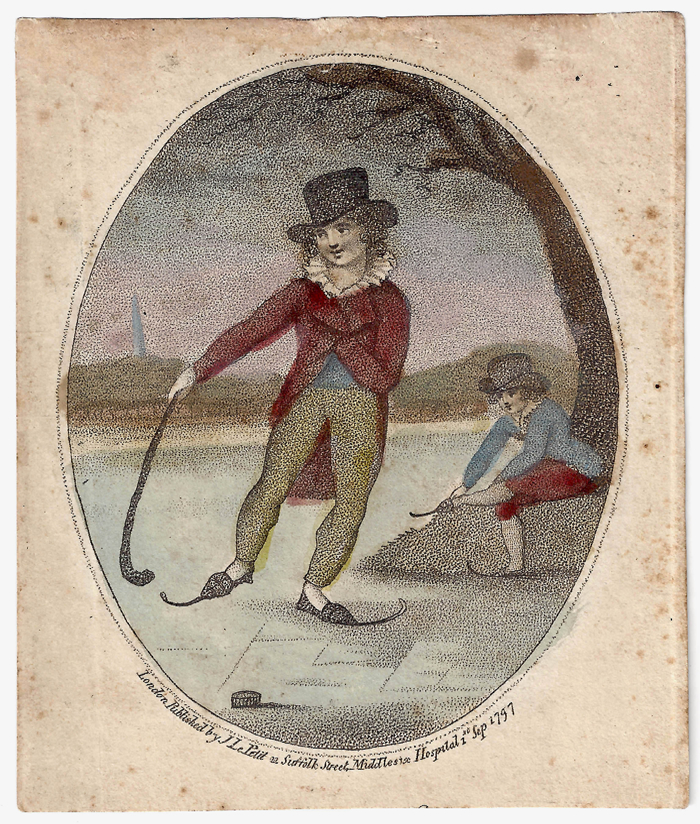
Oldest known image of Hockey on ice skates - 1797 - London - England
All countries have games peculiar to their environment and climate. For the most part, ball games and stick-ball games originated from a basic game called Camp Ball. The first ever English-Latin dictionary, Promptorium parvulorum (ca. 1440), offers the following definition of camp ball: "Campan, or playar at foott balle, pediluson; campyon, or champion" The game was originally played in the middle of town where the objective was to take the ball to the opposing side of town. It was later played in the country often in a special field set aside for the purpose known as a camping-place, camping close or camping pightle. The custom in Medieval times was to play games after Church services and often camping fields were sited near the Church. Community games thus developed which involved various objects being kicked, then hit with sticks on the ground, and finally in the air. Football, rugby, golf, field Hockey, ricket, hurley, shinty, bandy, rounders and a host of variations evolved from this initial, simple game.
First Ice Skates - There is a written description of a scene taking place below the northern city walls of Canterbury during the winter, drawn up in Latin and published in 1180, which was translated by Stow, a London chronicler, into English in the 16th century. The account was written by a man named William Fitzstephen, who, at the time, was secretary to the Archbishop of Canterbury Thomas Beckett, and reads as follows: when the great fenne or moore (which watereth the walles of the citie on the north side) is frozen, many young men play upon the yce, some striding as wide as they may, doe slide swifly, some tye bones to their feete, and under their heeles, and shoving themselves by a little picked staffe, doe slide as swifly as birde flyeth in the aire, or a arrow out of a crossbow. Sometime two runne together with poles, and hitting one another, eyther one or both doe fall, not without hurt; some break their armes, some their legs, but youth desirous of glorie, in this sort exerciseth it selfe against time of warre.

A study by Federico Formenti of the University of Oxford suggests that the earliest ice skating happened in southern Finland more than 3000 years ago. Originally, skates were merely sharpened, flattened bone strapped to the bottom of the foot. Skaters did not actually skate on the ice, but rather glided on top of it. MORE INFORMATION AVAILABLE AT Bone Skates Database
The Lakota / Teton-Sioux of North-South Dakota, USA played a ball and stick game on ice , using two sharp pieces of carved buffalo shoulder bone attached to flat birchwood runners as skates, and bent tree branches as sticks.
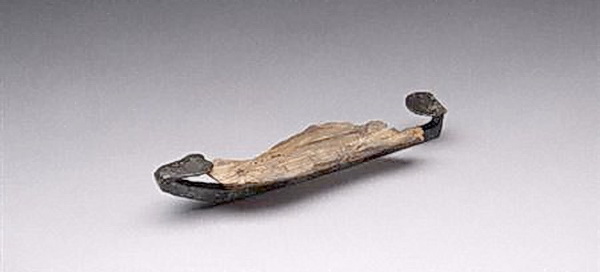
This photo of a ice skate circa 1225, shows what is left of a wooden platform that was covered by a runner blade of approximately 10mm wide. The blade was hooked fore and aft as to fix it to the wood. The front is prow like shaped and the rear is right angled. True skating emerged when a steel blade with sharpened edges was used. Skates now cut into the ice instead of gliding on top of it. Adding edges to ice skates was invented by the Dutch in the 13th or 14th century. These ice skates were made of steel, with sharpened edges on the bottom to aid movement.

The first depiction of ice skating in a work of art was made in the 15th century. The picture, of Saint Lidwina, patron saint of ice skaters, falling on the ice was the first work of art to feature ice skating as a main theme. Another important aspect of the woodcut print is a man seen in the background, who is skating on one leg. This means that the ice skates the man was wearing must have sharp edges similar to those found on modern ice skates.
The earliest reference to a stick and ball game played on ice, is from the Dublin Evening Post in Ireland, who reported on January 29, and February 2 of 1740 that two teams of Gentlemen played "a match of hurling" on the frozen River Shannon.
Thomas Chandler Haliburton, was born in Windsor, Nova Scotia, Canada in 1796. Haliburton was educated at King's College, with arts and law degrees, Haliburton became a lawyer, judge and author of note. He wrote the first historical account of Nova Scotia in 1829 and created a fictional character named Sam Slick, a comic Yankee clockmaker noted for salesmanship and wise sayings. He was the first Canadian to acquire international acclaim as an author, Haliburton is commonly known as "the Father of American Humor"


As the King's College boys began playing hurley on ice, so began the evolution of ice Hockey. Nova Scotia's newspapers document the gradual and steady development of ice hurley into ice Hockey within the province prior to its eventual spread across the Canada. In April, 1898, an article on ice Hockey by Dr. A. H. Beaton, secretary of the Ontario Hockey Association, appeared in the Canadian Magazine. "Nearly twenty years ago," he wrote, "Hockey, as a scientific sport, was introduced into Upper Canada from Nova Scotia, the latter being the indisputable home in Canada of this game."

From King's College, ice hurley spread to Fort Edward where soldiers also took up the new game. They traveled back and forth between Windsor, Halifax, and Dartmouth and the game gained impetus in the 1820s and 1830s as it was played on the magnificent Dartmouth lakes and frozen inlets of Halifax Harbour. Thomas H. Raddall, a noted Nova Scotia historic novelist, wrote of the soldiers in Warden of the North that "When [they] were transferred to military posts along the St. Lawrence and the Great Lakes, they took the game with them; and for some time afterwards continued to send to Dartmouth Indians for the necessary sticks." Many of the soldiers would have played cricket, hurley, shinty, bandy and early versions of field Hockey back at home. Cricket was very popular among both the British Regiments stationed at Halifax and the students at King's College.
Cricket, hurley, shinty, bandy and field Hockey influenced ice hurley as it developed into ice Hockey. Indeed, the game was sometimes called wicket, ricket and cricket, as well as hurley and Hockey. Mi'kmaq First Nations in Nova Scotia communities, who had their own field and ice game called Oochamkunutk, tooadijik and wolchamaadijik, gradually joined with ice hurley players, melding their games. The Mi'kmaq referred to ice hurley as "Alchamadijik."
It is well known too that when settlers from Wester Ross, Sutherland and East Inverness-shire arrived in Pictou, Nova Scotia in 1773, aboard the vessel "Hector", whether the assembled masses had taken time to pack shinty sticks amongst what little possessions they could take with them is extremely unlikely. There is little doubt, however, that once they got to Canada, they took up where they left off at home in many respects. Many other vessel's from the ports in the Highlands starting arriving in Pictou, Quebec, Prince Edward Island and other ports in Canada. Their sports and pastimes were just about all they had in the face of extreme adversity as the store of songs which has survived shows. It appears, however, that the people adapted as soon and as best they could in trying circumstances.

Sir John Franklin wrote in 1825, "Till the snow fell the game of Hockey played on the ice was the morning sport" on Great Bear Lake during one of his Arctic expeditions.
A mid-1830s watercolor portrays New Brunswick lieutenant governor Archibald Campbell and his family with British soldiers on skates playing a stick-on-ice sport.
The Moffatt Stick - Oldest known stick used for ice Hockey / ice Hurley
The Stick is made from a root of Nova Scotia Sugar Maple. Weighs 1.7 lbs and mearsures 41 1 /2 inches tip to toe, 34 inches tip to heel and 13 inches along the three-quarter-inch-thick rockered blade.
The Moffatt Stick was taken to Colin Laroque, a tree-ring scientist at Mount Allison University in Sackville, N.B. Because of a knot in the flat top of the stick, Laroque dated the tree to between 1835 and 1838. He even found five layers of paint on the stick that match popular paints used over the years.
This stick had been used by generations of the Moffatt family, including Warren C Moffatt - 1881-1963 and Thomas A Moffatt - 1837-1911.
The Moffatt Stick was most likely carved by the Mi'kmaq First Nations, which are famous stick carvers, and have inhabited Cape Breton and throughout Nova Scotia for centuries.
The Moffatt family played games on Pottle Lake in the Cape Breton area of Nova Scotia

Sir Richard George Augustus Levinge, a British Army officer in New Brunswick, wrote about "Hockey on ice" on Chippewa Creek (a tributary of the Niagara River) in 1839, "During the winter, the skating on Chippewa Creek was excellent and added not a little to our amusement. Large parties contested games of Hockey on ice, some forty or fifty beeing ranged on each side. A ludicrous scene, too, was afforded by the instruction of the black corps in skating: from the peculiar formation of a negro´s foot, and the length of his heel, they were constantly falling forward; it was impossible to keep them on their skates, and down they came in whole sections. They might have done admirably on snow-shoes, but it was lamentable to witness the dreadful "headers" they suffered from the skates."

In 1843 another British Army officer Sir Arthur Henry Freeling in Kingston, Ontario wrote, "Began to skate this year, improved quickly and had great fun at Hockey on the ice.
Sir John Dugdale Astley talks about his days in Oxford (Fifty Years of My Life: in the world of sport at home and abroad - 1894 - 2 volumes), playing hockey-on-the-ice as early as 1846.

He wrote the following:
“one of the best games in my humble opinion that man can play. That was an on-ice version of field Hockey in which all players were required to shoot right-handed and offside rules varied.” And, Just previous to Christmas, 1853, we had a lot of hard weather, and with some first-rate ice, which gave me ample opportunity of playing my favourite game of Hockey on the ice. Our other battalion was then quartered at Windsor, and it reached my ears that a match was to be played on the pond on the slopes below the Terrace of Windsor Castle, and, though I really had no business there, I felt very keen to show my powers before Royalty (the Royal family being at the Castle); so I smuggled myself down to the pond, and, as I was known to be useful at the game, Dudley de Ros of the 1st Life Guards and I tossed up for sides. The pond – as I recollect it – was an oval one with an island in the centre, on which the band of our regiment was stationed. At one end of the pond her Gracious Majesty was seated, surrounded by several ladies of the court, watching the game with evident interest. The Prince Consort – who was a beautiful and graceful figure-skater – kept goal for the opposite side, and Lord Listowel (father of the present Earl) kept ours. I don't think that I ever enjoyed a game more, and it was that day I first had the honour off making the acquaintance of the Prince of Wales. The game waxed fast and furious and I am afraid that I was sufficiently wanting in respect to interfere once, at least, with the Prince Consort's equilibrium in my eagerness to get a goal.
The edges of the pond sloped up to where Her Majesty was sitting, and in a desperate rally with De Ros I lost my balance and came down in a sitting posture, the impetus I had on carrying me right up to the Queen's feet, and the hearty laughter which greeted my unbidden arrival is still vividly impressed upon my mind. It was altogether a glorious afternoon's sport, but as the ice was beginning to thaw, and the surface was to a certain extent covered in water, I was wet to the skin, and only escaped a rheumatic attack by imbibing in plenty of deliciously mulled port-wine, which was served in a conservatory under the terrace. To this decoction, I suppose I must attribute my audacity in venturing to go down to the Foot-Guards barracks, where I received a jobation from the C.O. for having the effrontery to take part in a game to which I was not asked; but as I had played well I was not cashiered on this occasion.
The Medical Chronicle -- which was published in Montreal, Quebec. In the May, 1857 issue (Vol. 4, No. 12), a clinical lecture by Dr. W. Lawrence was discussing a Hockey-related injury treated in England "In the winter of 1850, it appears, the patient was playing on the ice; while engaged in some game, the precise nature of which I do not understand, and termed 'hocky' -- a game, as I learn (and you will correct me if I'm wrong,) where there is hard hitting of a ball, or hard hitting of a hard ball, which struck the side of the leg, or tibia, of this poor young man. He says he did not make anything of it at the time, nor did he interrupt his playing; he even went on in the excitement of the game till he unluckily got a second blow, but this time with the 'hocky' stick, on the identical same spot.
The Boston Evening Gazette printed a piece in November, 1859, entitled "Winter Sports in Nova Scotia," In Nova Scotia the time for ice is during the months of December, January and February. The lakes are then frozen and the ground generally covered with snow, although but seldom is there snow enough before Christmas to make sleighing. Skating is the favourite pastime during December, and, indeed, all through the winter, if - as is sometimes the case - there has been a great deal of snow.
There are some excellent skaters in this province, particularly in Halifax. I have seen young men who could cut their names in German text, or write the Lord's Prayer with skates on the ice easier than most skaters could cut the "outside edges." I don't like to be uncharitable, but I have known some skaters who, I think, would not be able to do it without a written or printed copy before their eyes. Throwing a somersault on skates is almost an impossibility yet I have seen it done successfully.
Fancy skating is not so much practiced now in Nova Scotia as formerly; more attention is paid to games on ice. Ricket is the favorite pastime, and is played thus. Two rickets are formed at about the same distance, one from the other, that cricketers place their wickets. If there are many players, the rickets are futher apart. A ricket consists of two stones - about as large as the cobble stones with which some of our streets have been lately paved - placed about three of four feet apart and frozen to the ice. Sides are then formed by two persons - one opposed to the other - tossing or drawing lots for first choice of partners.
The one who obtains the first choice selects one from the crowd, the other party then chooses another, and so on alternately, until a sufficient number is obtained on each side. Any number can play the game, and generally, the "more the merrier". Each ricketer is provided with a hurley, and all being ready a ball is thrown in the air, which is the signal to commence play, previous to which, however, a ricket is chosen by each side and placed in charge of a man whose duty it is to prevent the ball from passing through. The game maybe 10, 15 or 20, or any number agreed upon, the side counting the number first being the winners. The counting consists in putting the ball through your adversary's ricket, each time counting one. From the moment the ball touches the ice, at the commencement of the game; it must not be taken in the hand until the conclusion, but must be carried or struck about the ice with the hurlies. A good player - and to be a good player you must be a good skater - will take the ball at the point of his hurley and carry it around the pond and through the crowd which surrounds him trying to take it from him; until he works it near his opponents ricket, and "then comes the tug of war," both sides striving for the mastery. Whenever the ball is put through the ricket a shout "game ho!" resounds from shore to shore and dies away in hundreds of echos through the hills. Ricket is the most exciting game played on the ice"
Editor's Note:... "It might be well if some of our agile skaters would introduce the game. It would be a fine addition to our winter sports, and give a new zest to the delightful excercise of skating. We have sent down for a set of hurleys preparatory to its introduction."
London Society – An Illustrated Magazine, published in London, England in 1863, had the following article on ice Hockey: The various games that are played on the ice are mostly unworthy of a true skater's attention, and have the further drawback of seriously annoying those who use the skate for its legitimate purpose. Hockey, for example, ought to be sternly forbidden, as it is not only annoying, but dangerous. In its right place, Hockey is a noble game, and deserving of every encouragement, but on the ice it is in its wrong place, and should be prohibited. Any weak place in the ice is sure to give way if the ball should happen to pass over or near it; for the concourse of fifty or a hundred persons all converging • upon the same point is a test which no ice, save the very strongest, is able to bear. Even the express trains, so popular on the Serpentine, on a fine frosty night, are not nearly so dangerous as Hockey, because they distribute the weight over a large surface with tolerable equality. Moreover, when a mass of human beings precipitates itself recklessly in any direction where a ball may happen to run, accidents are certain to follow. The indifferent skaters, or those who are only walking on the ice, are knocked down, and often severely injured by others falling on them ; and if the ice should give way, as is likely to happen by reason of their accumulated weight, a fatal result is almost a necessary consequence.
A System of Figure-Skating - Being the Theory and Practice of the Art as Developed in England, With a Glance at Its Origin and History. Published in England in 1869 by authors H.E. Vandervell and T. Maxwell Witham, members of the London Skating Club. References to Hockey : "We must absolutely forbid the use on the ice of the walking-stick, as it is utterly useless as an artificial support for the learner, and excessively dangerous to every one in his immediate vicinity. We cannot conceive how any skater can take delight in skating about with such a thing flying in all directions. It is only useful when Hockey is in the case." and "We see this combination used by the many who run and race about, and play Hockey, which generally noisy game on the ice is hardly interesting for the skater, who aims at a higher branch of his art."

This photo postcard depicts a ice Hockey game at the Victoria Skating Rink - circa 1893
On March 3, 1875, the Victoria Skating Rink in Montreal, Quebec hosted what has been recognized as the first indoor organized ice Hockey game, between members of the Victoria Skating Club, organized by James G A Creighton. The match lays claim to this distinction because of several factors which establish its link to modern ice Hockey: it featured two teams (nine players per side), goaltenders, a referee, a puck, a pre-determined set of rules, including a pre-determined length of time (60 minutes) with a recorded score.
Games prior to this had mostly been outdoors, with sticks and balls, with informal rules and informal team sizes. In order to limit injuries to spectators and damage to glass windows, the game was played with a wooden puck instead of a lacrosse ball, possibly the first time such an object was used. The two teams, included a number of McGill University students and other members of the club, who were all English Montrealers - Torrance, Meagher, Potter, Goff, Barnston, Gardner, Giffin, Jarvis, Whiting, Campbell, Campbell, Esdaile, Joseph, Henshaw, Chapman, Powell, Clouston, and of course, Creighton
Sticks and skates for this game were imported from Nova Scotia, including Mi'kmaq sticks and Starr skates. This first game was pre-announced to the general public in the pages of The Montreal Gazette:
Announcement
Victoria Rink - A game of Hockey will be played at the Victoria Skating Rink this evening, between two nines chose from among the members. Good fun may be expected, as some of the players are reputed to be exceedingly expert at the game. Some fears have been expressed on the part of intending spectators that accidents were likely to occur through the ball flying about in too lively a manner, to the imminent danger of lookers on, but we understand that the game will be played with a flat circular piece of wood, thus preventing all danger of its leaving the surface of the ice. Subscribers will be admitted on presentation of their tickets.
Game report
HOCKEY -- At the Rink last night a very large audience gathered to witness a novel contest on the ice. The game of Hockey, though much in vogue on the ice in New England and other parts of the United States, is not much known here, and in consequence the game of last evening was looked forward to with great interest. Hockey is played usually with a ball, but last night, in order that no accident should happen, a flat block of wood was used, so that it should slide along the ice without rising, and thus going among the spectators to their discomfort. The game is like Lacrosse in one sense -- the block having to go through flags placed about 8 feet apart in the same manner as the rubber ball -- but in the main the old country game of shinty gives the best idea of Hockey. The players last night were eighteen in number -- nine on each side -- and were as follows: -- Messrs. Torrance (captain), Meagher, Potter, Goff, Barnston, Gardner, Griffin, Jarvis and Whiting. Creighton (captain), Campbell, Campbell, Esdaile, Joseph, Henshaw, Chapman, Powell and Clouston. The match was an interesting and well-contested affair, the efforts of the players exciting much merriment as they wheeled and dodged each other, and notwithstanding the brilliant play of Captain Torrance's team Captain Creighton's men carried the day, winning two games to the single of the Torrance nine. The game was concluded about half-past nine, and the spectators then adjourned well satisfied with the evening's entertainment.
Not reported in the Gazette, but reported elsewhere was that there was fighting after the game. This fighting was not between the on-ice combatants, rather, it was between the Hockey players and spectators and members of the Skating Club. Members of the Skating Club were opposed to the use of the skating rink for Hockey as it took away hours from other skating activities and it damaged the ice quality. According to the Kingston, Ontario Daily British Whig "Shins and heads were battered, benches smashed and the lady spectators fled in confusion."

The Montreal Daily Witness reported on the game on March 4, 1895 : Hockey in the Victoria Skating Rink. - Last evening a game of hockey was played in the Victoria Skating Rink between two nines, Messrs Torrance (Captain), Meagher, Potter, Goff, Barnston, Gardner, Griffin, Jarvis, and Whiting; and Messrs Creighton (Captain), Campbell, Campbell, Esdaile, Joseph, Henshaw, Chapman, Powell and Clouston. The game is generally played with a large rubber ball, each side striving to knock it through the bounds of the other's field. In order to spare the heads and nerves of the spectators, last evening, a flat piece of board was used instead of a ball; it slid about between the players with great velocity; the result being that the Creighton team won two games to one for the Torrance. Owing to some boys skating about during the play, an unfortunate disagreement arose; one little boy was struck across the head, and the man who did so was afterwards called to account, a regular fight taking place in which a bench was broken and other damage caused. It was the intention of the players to have another game, but this disgraceful affair put a stopper on it.
This game played is the earliest eyewitness account of a ice Hockey game.
As ice Hockey began in Montreal, it was played according to Halifax Hockey Club Rules, but the forward pass was not allowed. Not until the Dartmouth Chebuctos traveled to Montreal in 1889 for a tournament. The excitement of the Nova Scotia forward pass would be tried in competition by the Montreal Hockey Club, Montreal Crystals and the Quebec Hockey Club. The Chebuctos would lose all 4 game it played - 6 to 1 vs the Montreal Hockey Club, 4 to 1 vs the Montreal Crystals and 8 to 0 / 5 to 1 vs Quebec Hockey Club. All 4 games were played at the Crystal Rink in Montreal. It would be more than 30 years before forward passing was adopted by the Hockey establishment.
The McGill University Hockey Club, the first ice Hockey club, was founded in January 1877 by McGill students James G A Creighton, Henry Joseph, Richard F. Smith, W.F. Robertson and W.L. Murray.
The original Halifax Rules as recorded by sports reporter James Power were as follows:
1 - The game was played with a block of wood for a puck.
2 - The puck was not allowed to leave the ice.
3 - The stones marking the place to score goals were placed on the ice parallel to the sides of the ice surface.
4 - There was to be no slashing.
5 - There was to be no lifting the stick above the shoulder.
6 - When a goal was scored, teams changed ends.
7 - Players had to keep 'on side' of the puck.
8 - The forward pass was permitted.
9 - All Players played the entire game.
10 - There was a no-replacement rule for penalized players.
11 - The game had two thirty minute periods with a ten minute break.
12 - The goal-keeper had to stand for the entire game.
Goals were decided by the goal umpires, who stood at the goalmouth and rang a handbell.
The simplified McGill Rules were:
1 - The game shall be commenced, and renewed by a Bully from the center of the ground. Goals shall be changed after each game.
2 - When a player hits the ball, any one of the same side who at such moment of hitting is nearer to the opponents' goal line is out of play, and may not touch the ball himself, or in any way whatever prevent any other player from doing so, until the ball has been played. A player must always be on his own side of the ball.
3 - The ball may be stopped, but not carried or knocked on by any part of the body. No player shall raise his stick above his shoulder. Charging from behind, tripping, collaring, kicking or shinning shall not be allowed.
4 - When the ball is hit behind the goal line by the attacking side, it shall be brought out straight 15 yards, and started again by a Bully; but, if hit behind by any one of the side whose goal line it is, a player of the opposite side shall hit it out from within one yard of the nearest corner, no player of the attacking side at that time shall be within 20 yards of the goal line, and the defenders, with the exception of the goal-keeper, must be behind their goal line.
5 - When the ball goes off side, a player of the opposite side to that which hit it out shall roll it out from the point on the boundary line at which it went off at right angles with the boundary line, and shall not play it until it has been played by another player, every player being then behind the ball.
6 - On the infringement of any of the above rules, the ball shall be brought back and a bully shall take place.
7 - All disputes shall be settled by the Umpires, or in the event of their disagreement, by the referee.
The 1st photo of a ice Hockey team was taken in 1881 by George Charles Arless at the Crystal Palace Skating Rink in Montreal, Quebec, Canada. The team was the McGill University Hockey Club.
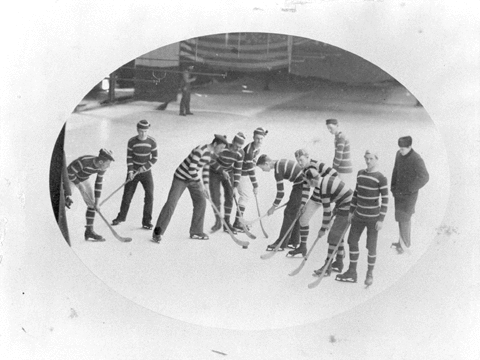
Pictured here are Albert P Low, W. W. Weeks, P. L. Foster, T. Drummond, R. C. Smith, J. A. Kinlock, Frederick Hague, F. W. Skaife, John J. Collins, W. L. Murray and Frank Weir.
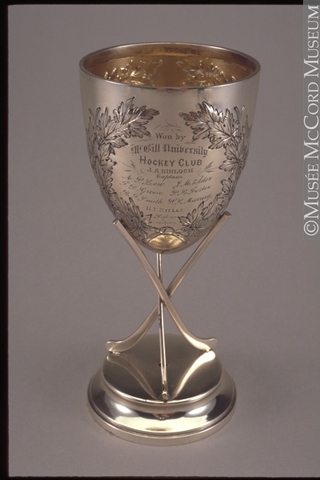
The 1st ice Hockey championship was held January 26, 27, 28, 1883 at the Montreal Winter Carnival in Quebec, Canada.
Three teams competed in the tournament that was held on the St. Lawrence River, Crystal Palace Skating Rink and the Victoria Skating Rink. The McGill University Hockey Club - J. A. Kinloch (captain), Albert Peter Low, T. D. Green, R. F. Smith, J. M. Elder, P. L. Foster and W. L. Murray. The Quebec City Hockey Club - W. Scott (captain), F. Ashe, A. Scott, M. Swift, A. Colley, S. Valler and A. Davidson. The Montreal Victorias - Charles Lamothe (captain), S. Abbott, J. Arnton, E. Sheppard, E. Stevenson, J. Muir and D. M. Watt.
The Championship Trophy awarded to the McGill University Hockey Club has been called The Carnival Cup, The Birks Carnival Cup and is engraved with "Winter Carnival 1883 Hockey Match" on one side, and engraved on the other side with the name and roster of the McGill University Hockey Club.
This trophy is on display at the McCord Museum in Montreal, Quebec, Canada
The oldest known image of a ice Hockey game was taken during the 1884 Montreal Winter Carnival on the athletic field at McGill University in Montreal by Alexander Henderson.
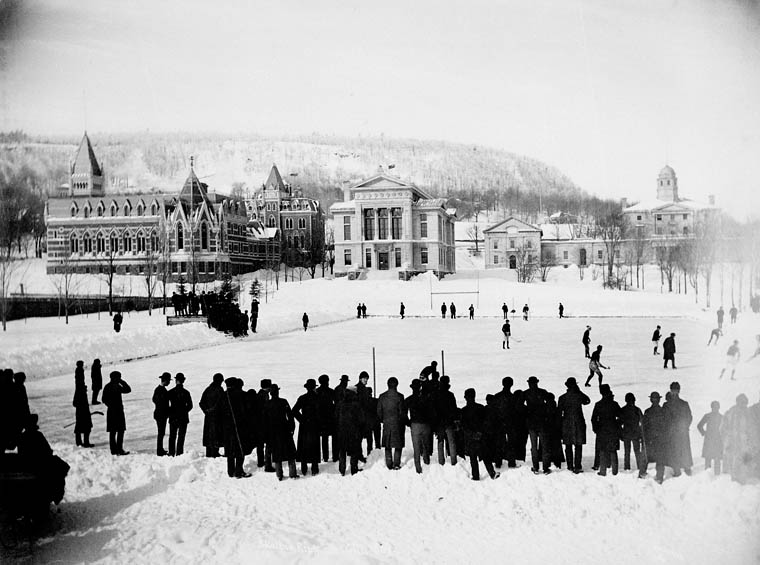
The Earliest known ice Hockey medals are from Thomas Laird Paton - 1885. Montreal Winter Carnival Champions. Paton's Montreal Hockey Club would win the championship in style, defeating the defending champions - McGill University Hockey Club in the semifinal game, after nine periods of play 1 to 0. In the championship game, the Montreal Hockey Club would again need overtime to defeat Ottawa 1 to 0. All games played at the covered Crystal Rink in Montreal.
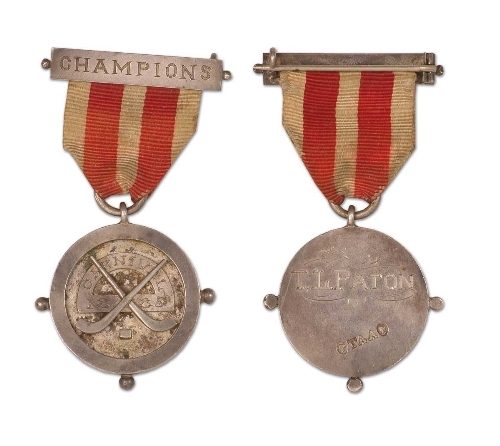
Tom Paton played the position of Goaltender for the Montreal HC (Montreal AAA) and was a member of the first Stanley Cup Winning Team in 1893 - Tom was a pioneer goaltender in organized Hockey.
Tom's Hockey career can be traced back to the early Montreal Carnivals prior to the formation of the AHAC in 1885 - He would be a founding member of the Montreal Amateur Athletic Association Hockey team (Montreal HC).
His career would be marked by dominance. Throughout every season he played between 1888 and 1893 for the Montreal AAA, his team would win the AHAC championship.
Tom Paton is most notable to be the first goaltender in Stanley Cup history to be awarded the trophy
The 1st ice Hockey League was started in Kingston, Ontario in 1885 when four teams - Queen's University, Royal Military College, Kingston Athletics and Kingston Hockey Club agreed to play a schedule of games through the winter into 1886. Queen's University defeated Kingston Athletics 3 to 0 in the 1st league championship game.
The 1st official ice Hockey league was the Amateur Hockey Association of Canada (AHAC), founded on December 8, 1886 by members of the Montreal Amateur Athletic Association, Montreal Victorias, Montreal Crystals, McGill University Hockey Club and the Ottawa Hockey Club. Thomas Daniel Green, a Mohawk First Nations was elected the 1st President.
MORE HISTORY TO BE ADDED SOON
The Most Important Part of Ice Hockey - The Stick
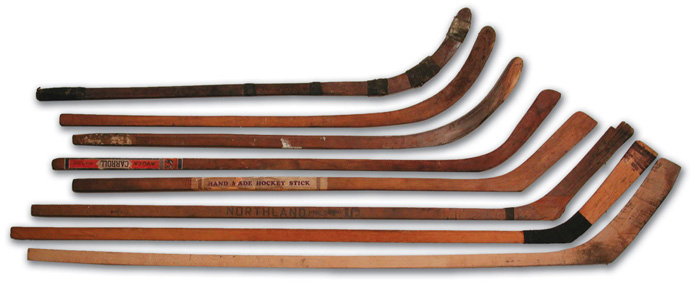
Ice Hockey sticks have had many shapes and styles since the first days of playing on ice. The sticks used in the very early days of any stick and ball games (played on any surface) were made from tree branches. The blade part of the stick was the root, and the stem growing up, was the shaft. Depending on the type of tree, grown on a slope - or not, and curing methods, the sticks could be shaped to the Warriors (players) liking, be very strong and have the ability to use as a weapon.
Ice Hockey sticks have varied over the years and centuries, different games played on many types of ice surfaces, have slowly evolved and influenced the ice Hockey stick. The style and shape of the ice Hockey stick as we know it today worldwide, is a design and 1st made by the Mi'kmaq First Nations of Nova Scotia.

The first recorded production of Hockey sticks in Canada was carried out by the Mi'kmaq First Nations of Nova Scotia, who carved them out of a wood called hornbeam, also known as ironwood because of its strength. When the hornbeam was used up, the carvers turned to yellow birch.
The Mi'kmaq people have inhabited the east coast of what is now Canada for centuries. They were the 1st to meet exporers, were very friendly and were guides for further exploration deep into their lands. The games of the Mi'kmaq people melded together with the games of the New World People, where slowly the game of ice Hockey developed. The students of early versions of these games took what they learned back home with them, and helped develope the game and the ice Hockey sticks further.



































